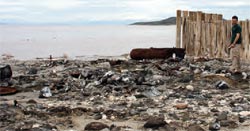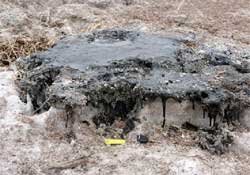Rozel Point
Miocene to Pliocene (24 to 1.8 million years old) organic-rich lake sediments probably generated the oil at Rozel Point. Rozel Point isn't the place to take a date! In the August 1995 issue of Survey Notes, Thomas Chidsey wrote of "crude oil dripping from abandoned wellheads, tar on rocks and beach sands, and dead pelicans along the beach." The wellheads have since been capped, but rusting industrial debris remains. The horrible stench of oil fills your nostrils at this Earthcache. Graceful flocks of pelicans flying by and distal views of the lake and mountains can inspire awe and wonder. The red brine, white salt, and black basalt impart an otherworldly feel.
Ever wonder where oil comes from?
Biogenic Theory: In the leading theory, dead organic material accumulates on the bottom of oceans, riverbeds or swamps, mixing with mud and sand. Over time, more sediment piles on top and the resulting heat and pressure transforms the organic layer into a dark and waxy substance known as kerogen. Left alone, the kerogen molecules eventually crack, breaking up into shorter and lighter molecules composed almost solely of carbon and hydrogen atoms. Depending on how liquid or gaseous this mixture is, it will turn into either petroleum or natural gas. Scientists aren't really sure how long this process takes but they figure it's probably on the order of hundreds of thousands of years.
Abiogenic Theory: In the 1950's, a few scientists began questioning this traditional view and proposed instead that petroleum could form naturally deep inside the Earth. Abiogenic petroleum might seep upward through cracks formed by asteroid impacts to form underground pools. Some geologists have suggested probing ancient impact craters in the search for oil. Abiogenic sources of oil have been found, but never in commercially profitable amounts. The controversy isn't over whether naturally forming oil reserves exist. It's over how much they contribute to Earth's overall reserves and how much time and effort geologists should devote to seeking them out. If abiogenic petroleum sources are indeed found to be abundant, it would mean Earth contains vast reserves of untapped petroleum and, since other rocky objects formed from the same raw material as Earth, that crude oil might exist on other planets or moons in the solar system. Both processes for making petroleum likely require thousands of years. Even if Earth does contain far more oil than currently thought, it's inevitable that reserves will one day run out. Scientists disagree sharply, however, on when that will occur. And, some say, a global crisis could begin as soon as increasing demand is greater than supply, a possibility that might be measured in years rather than decades, some analysts argue.


How to get there: Drive to the Golden Spike National Historic Site (GSNHS), 30 miles (45 km) west of Brigham City, Utah by following signs on Utah State Route 83 through Corinne.
Once at GSNHS take the gravel road leading west toward the West Side Drive approximately 6 miles (9 km) to an intersection that has a small white "Promontory Ranch" sign.
Take the south (left) road from the "Promontory Ranch" sign intersection and continue south about 1 mile (1.5 km) to an intersection near a corral; veer right to the road that heads southwest and continue about 9 miles (13.5 km) to Great Salt Lake at Rozel Point. You will see a linear jetty associated with past oilfield activity.
To claim this Earthcache do three things:
1) Post a picture of your GPS next to an oil seep in your log entry (optional).
2) There is widespread discussion on whether or how much ecological damage the seeps are doing to the area. Please email me the number of bird bodies you see in the immediate area.
3) Finally, there is allot of discussion about how much crude is actually seeping out of the ground in this area. In your email with a count of birds give me your best guess as to how many gallons of oil have seeped from the ground.